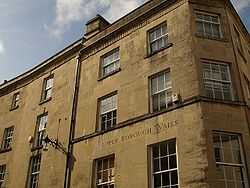Upper Borough Walls, Bath
| Upper Borough Walls | |
|---|---|
 | |
| Location | Bath, Somerset, England |
| Coordinates | 51°22′59″N 2°21′36″W / 51.38306°N 2.36000°WCoordinates: 51°22′59″N 2°21′36″W / 51.38306°N 2.36000°W |
Listed Building – Grade I | |
| Official name: Medieval Wall of City | |
| Designated | 12 June 1950[1] |
| Reference no. | 443855 |
Listed Building – Grade II | |
| Official name: Royal National Hospital for Rheumatic Diseases | |
| Designated | 11 August 1972[2] |
| Reference no. | 443857 |
Listed Building – Grade II | |
| Official name: Number 10 | |
| Designated | 5 August 1975[3] |
| Reference no. | 447732 |
Listed Building – Grade II | |
| Official name: Number 11 and 12 | |
| Designated | 5 August 1975[4] |
| Reference no. | 447733 |
Listed Building – Grade II | |
| Official name: Full Moon Hotel (Number 14) | |
| Designated | 5 August 1975[5] |
| Reference no. | 447734 |
 Location of Upper Borough Walls in Somerset | |
Upper Borough Walls is a historic street in Bath, Somerset, England. Many of the structures are listed buildings.
It takes its name from the section of the medieval wall of the city which still remains.[1]
The Royal National Hospital for Rheumatic Diseases was founded in 1738 as The Mineral Water Hospital, and is still known locally as The Min. Then, it provided care for the impoverished sick who were attracted to Bath because of the supposed healing properties of the mineral water from the spa. The original building was designed by John Wood the Elder and built with Bath stone donated by Ralph Allen. It was later enlarged, firstly in 1793 by the addition of an attic storey and later in 1860 by a second building erected on the west side of the earlier edifice. It is a Grade II listed building.[2] There is a fine pediment, in Bath stone, on the 1860 building depicting the parable of the good Samaritan.
Number 10 was built between 1800 and 1820,[3] when numbers 11 and 12 were built. Number 11 had a new shop front around 1900.[4] The Full Moon Hotel is slightly earlier having been built between 1780 and 1800.[5]
Numbers 18 and 18A, on the corner of Trim Street were built between 1730 and 1750.[6] Broadleys Vaults Public House and Gascoyne House also make up a listed building.[7]
See also
- List of Grade I listed buildings in Bath and North East Somerset
References
- ↑ 1.0 1.1 "Medieval Wall of City". Images of England. English Heritage. Retrieved 2009-09-03.
- ↑ 2.0 2.1 "Royal National Hospital for Rheumatic Diseases". Images of England. Retrieved 2006-06-24.
- ↑ 3.0 3.1 "Number 10". Images of England. English Heritage. Retrieved 2009-09-03.
- ↑ 4.0 4.1 "Numbers 11 and 12". Images of England. English Heritage. Retrieved 2009-09-03.
- ↑ 5.0 5.1 "Full Moon Hotel (Number 14)". Images of England. English Heritage. Retrieved 2009-09-03.
- ↑ "Numbes 18 and 18A". Images of England. English Heritage. Retrieved 2009-09-03.
- ↑ "Broadleys Vaults Public House and Gascoyne House". Images of England. English Heritage. Retrieved 2009-09-03.